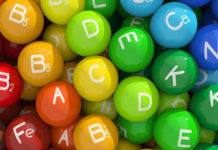A soluble white crystalline vitamin that occurs in the outer coat of rice and other grains. It forms part of the vitamin B complex and is essential for carbohydrate metabolism: deficiency leads to nervous disorders and to the disease beriberi. Formula: C12H17ON4SCl.H2O. Also called vitamin B1, Aneurin.
Because thiamine is water-soluble, any extra is passed out of the body in the urine. Thiamine is needed each day to maintain health.

Thiamine is found in foods such as:
• meats (pork and liver)
• brewer’s yeast
• soybeans
• peanuts
• dried beans
• whole or enriched breads, grains, and cereals
Enriched products add back the vitamins that are lost when grains are processed. Thiamine is lost in cooking due to heat. The thiamine contents of some foods are:
• beef liver, braised (3 ounces) = 9.2 milligrams (mg)
• sunflower seeds (3.5 ounces) = 1.96 mg
• pinto beans (3.5 ounces) = 0.84 mg
• enriched rice, cooked (1/2 cup) = 0.2 mg
How Does The Nutrient Affect The Body?
Thiamine works with the other B vitamins to change protein, carbohydrate, and fat to energy. It is especially vital for changing carbohydrates to energy. It is a key factor in the healthy functioning of all the body’s cells, especially the nerves.Daily needs for thiamine are based on the amounts of calories taken in each day. The recommended daily allowances, called RDAs, for thiamine are based on 0.5 milligram (mg) for every 1,000 calories consumed. Based on the recommended calorie intake for men and women at certain age levels, the RDAs for thiamine are:
• men from 15 to 50 years = 1.5 mg
• men over 50 years = 1.2 mg
• women from 11 to 50 years = 1.1 mg
• women over 50 years = 1.0 mg
• pregnant women = 1.5 mg
• breastfeeding women = 1.6 mg
Thiamine is common in foods. A balanced diet based on the Food Guide Pyramid should provide enough thiamine daily.

A disease called beriberi, which affects the nerves and heart, is caused by a lack of thiamine in the diet. This is extremely rare in the United States, because enriched grain products are so common. Before grains were enriched, it was much more common.
Mild thiamine deficiencies are more common. Exceptions may be found with chronic alcoholism, fasting, the elderly, and chronic dieting. Symptoms usually show up in the nerves, stomach, and heart. Early warning signs include:
• fatigue and weakness
• loss of appetite and weight loss stomach upset and nausea
• confusion and irritability
• depression
• poor memory
• sleep disturbances
• chest pain
• irritation
• abdominal discomfort
• constipation
If deficiency continues, symptoms can get worse, and some damage can be permanent. This can include damage to the heart, and changes to the nervous system.
There is little chance of getting too much thiamine, even when it is taken at high doses. Because it is water soluble and not stored in the body, it is not likely to build up to toxic levels. In older people with low levels of thiamine, taking vitamin B1 pills has improved their lives by decreasing both blood pressure and weight.
In isolated cases, however, thiamine toxicity has occurred from injections or concentrated formulas used with hospital patients.
Toxicity symptoms include nervous irritability, headaches, insomnia, and a rapid pulse.
© Copyright – Hector Sectzer

















